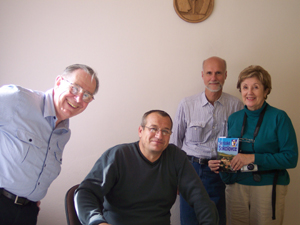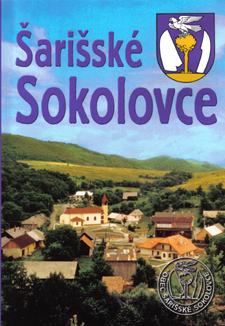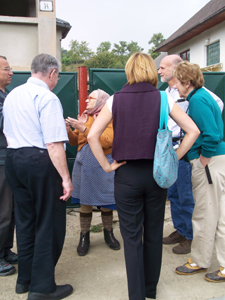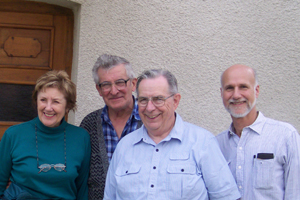The tiny dedina (village) of Sarisske Sokolovce is less than a half hour from Presov, following
a narrow country road past farms and pastures.
 Sarisske Sokolovce
We arrived fairly early in the morning, just as
people were beginning their morning routines. We found a cemetery and explored it, looking for
the Jurus ancestors of Bob, Tom and Marilyn. Alas, there were none, so we went further into town.
Sarisske Sokolovce
We arrived fairly early in the morning, just as
people were beginning their morning routines. We found a cemetery and explored it, looking for
the Jurus ancestors of Bob, Tom and Marilyn. Alas, there were none, so we went further into town.
We had a house number from a 19th-century census. Surely the numbering system must have changed
by now, but we looked anyway. These substantial houses sit next to the sidewalks, some with
front yards, apparently all with backyards containing gardens and, frequently, chickens. As we
stood in the road, trying to decide what to do next, a woman approached. Bob showed her the paper
on which he had written, in Slovak, that we are looking for descendants of our great-grandfather
Andras Jurus.
The woman firmly took his hand and led him to a large building, up the driveway, around to the
back door where she left him. It was the mayor's office.
Anton Durkac is the starosta (mayor), a charming, friendly man who has held this office for
 With Starosta Anton Durkac
almost two decades. Understanding immediately the language problem, he pulled out his cell phone
and started calling people. While he waited, we showed him the book of photos and the family tree
of the Jurus family, and tried to explain that we wanted to give it to the library for the use of
the people of the village.
With Starosta Anton Durkac
almost two decades. Understanding immediately the language problem, he pulled out his cell phone
and started calling people. While he waited, we showed him the book of photos and the family tree
of the Jurus family, and tried to explain that we wanted to give it to the library for the use of
the people of the village.
Within minutes, people started returning his calls, and within a half hour he had located a young
woman, a professor at the University in Presov, who happened to be in Sarisske Sokolovce visiting
her sister. She soon arrived and began translating.
 The village history book
As we had thought, all of the descendants of our great-grandfather Andras Jurus had left the village.
There are Jurus descendants still living there, but they are more distantly related. So there were
no cousins to find, but we were happy to give the book to the mayor. When he understand that this
was a gift to the village, he smiled happily and returned the favor by giving us copies of the booklet
he had recently published about Sarisske Sokolovce, along with some more photographs.
The village history book
As we had thought, all of the descendants of our great-grandfather Andras Jurus had left the village.
There are Jurus descendants still living there, but they are more distantly related. So there were
no cousins to find, but we were happy to give the book to the mayor. When he understand that this
was a gift to the village, he smiled happily and returned the favor by giving us copies of the booklet
he had recently published about Sarisske Sokolovce, along with some more photographs.
He wanted to show us around, so we all walked up the street to the main cemetery. The ground was
covered with fallen leaves and with walnuts -- he picked one up and cracked it for us, and enjoyed
 The Jurus family home site
our pleasure as we picked up more for ourselves. Throughout Slovakia we found walnuts and chestnuts
covering the ground in parks and along sidewalks. Both children and adults picked them up.
The Jurus family home site
our pleasure as we picked up more for ourselves. Throughout Slovakia we found walnuts and chestnuts
covering the ground in parks and along sidewalks. Both children and adults picked them up.
Along the way, Mayor Durkac showed us the home in which our grandmother was born. It has recently
been restored, but some of the outbuildings behind the house might date back to the 19th century.
A Jurus family lives there, but they are descended from a Gyorgy Jurus and not Andras Jurus, so they
 A distant Jurus relative
may be third (or more) cousins. Without a definite genealogical record, this is too distant to
qualify in Slovak minds as rodina (“family.”)
A distant Jurus relative
may be third (or more) cousins. Without a definite genealogical record, this is too distant to
qualify in Slovak minds as rodina (“family.”)
In the cemetery, he showed us some of the Jurus graves, and described to us (always with the
exceptional skills of our translator) how the cemetery had been designed. We learned that, as we
had suspected, only more recent graves had markers. When we were lucky enough to find a family
grave with a full marker, it was a genealogical treasure, because the marker would list husband and
wife with their dates of birth and death, and also the maiden name of the wife.
A born politician, the mayor thoroughly enjoyed walking with us through the village, chatting with
passersby who clearly knew that four Americans had come to town.
 The Greek Catholic chapel
Near the cemetery we stopped at the small Greek Catholic chapel. The mayor had phoned the Greek
Catholic priest, Farar (Father) Ing. Jozef Maslej, who was prepared to tell us his story. He
was an excellent and powerful speaker, and of course the Professor of English was a great translator!
The Greek Catholic chapel
Near the cemetery we stopped at the small Greek Catholic chapel. The mayor had phoned the Greek
Catholic priest, Farar (Father) Ing. Jozef Maslej, who was prepared to tell us his story. He
was an excellent and powerful speaker, and of course the Professor of English was a great translator!
Father Maslej was enrolled in the school of theology when the communists came to power. He was arrested
and forbidden from continuing his studies of theology, and so became an Inzinier, which is roughly
equivalent to a bachelor's degree. Finally, after a 40-year delay, he was able to complete his
 With Father Jozef Maslej
theological studies and become ordained as a priest.
With Father Jozef Maslej
theological studies and become ordained as a priest.
The tiny but lovely Greek Chapel used to be a private chapel for a landowner's family, perhaps
for only one mass a year. It does not have a full iconostasis, but his daughter, who studied art
at the university, drew the icon over the altar. This work, together with icons for two other churches,
constituted her master's project. It depicted St. Mary, the archangels Michael and Gabriel, the twelve
apostles, and Jesus in heaven surrounded by angels. His congregation numbers about 18 members, who,
through their contributions, paid for the chapel to be converted, restored and consecrated to their
faith as a church. Father Maslej invited us to his daily mass and gave us his blessing.
Mayor Durkac walked us back into town to see the Roman Catholic church. Like churches in all of the
 Rebuilt Roman Catholic church
other towns we visited, this church was completely rebuilt around 2002. And like all of the churches,
the art work was beautiful and clearly beloved. We were able to find a few old statues and pictures
-- items which might have been in the church when our grandmother Anna Jurus was baptized there.
Rebuilt Roman Catholic church
other towns we visited, this church was completely rebuilt around 2002. And like all of the churches,
the art work was beautiful and clearly beloved. We were able to find a few old statues and pictures
-- items which might have been in the church when our grandmother Anna Jurus was baptized there.
To finish our visit, we drove into a larger nearby town, Sabinov, where we treated our translator and
our mayor to a delicious luncheon, including pierogies and local trout. We enjoyed the luncheon so
much that, after bidding farewell to Sarisske Sokolovce, we returned to Presov and checked out of the
Hotel Dukla, moving into the friendly new Torysa Hotel in Sabinov, which would be our headquarters
for the rest of our stay in the region.
 Sarisske Sokolovce
We arrived fairly early in the morning, just as
people were beginning their morning routines. We found a cemetery and explored it, looking for
the Jurus ancestors of Bob, Tom and Marilyn. Alas, there were none, so we went further into town.
Sarisske Sokolovce
We arrived fairly early in the morning, just as
people were beginning their morning routines. We found a cemetery and explored it, looking for
the Jurus ancestors of Bob, Tom and Marilyn. Alas, there were none, so we went further into town.
 With Starosta Anton Durkac
With Starosta Anton Durkac The village history book
The village history book The Jurus family home site
The Jurus family home site A distant Jurus relative
A distant Jurus relative The Greek Catholic chapel
The Greek Catholic chapel With Father Jozef Maslej
With Father Jozef Maslej Rebuilt Roman Catholic church
Rebuilt Roman Catholic church